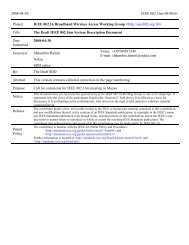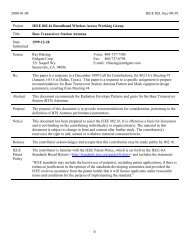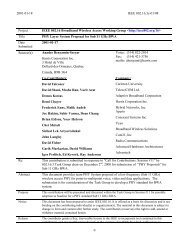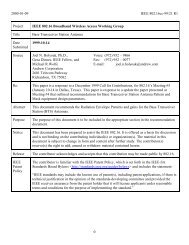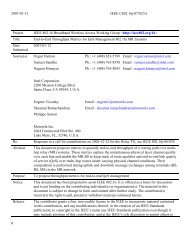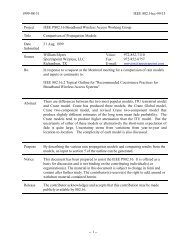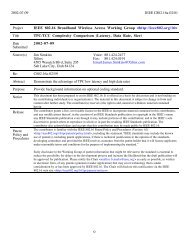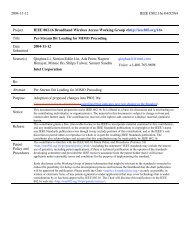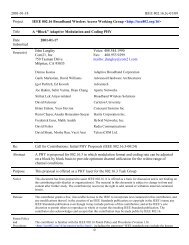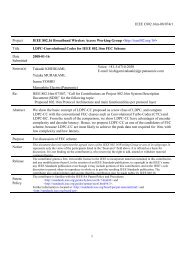802.16.1 Functional Requirements, Rev. 1 - LMSC, LAN/MAN ...
802.16.1 Functional Requirements, Rev. 1 - LMSC, LAN/MAN ...
802.16.1 Functional Requirements, Rev. 1 - LMSC, LAN/MAN ...
You also want an ePaper? Increase the reach of your titles
YUMPU automatically turns print PDFs into web optimized ePapers that Google loves.
12345678910111213141516171819202122232425262728293031323334353637383940411999-12-17 IEEE 802.16s-99/00r1• Low delay – as apparent to the end users, the amount of delay between a user speaking andanother user hearing the speech MUST be kept below a certain level to support two-wayconversation. Again, the specific amount of delay can vary based on the quality of the servicesold to the end user.• Timing - (Fractional) DS1/E1 services require timing to be delivered from the network to theend user's equipment, whether the timing is synchronous with the network (i.e., based on theserving network's clock) or asynchronous with the network (based on a clock other than theserving network's clock).BWA protocols MUST support efficient transport of encoded voice data in terms of bandwidth,reliability and delay. Other properties are managed by digital signaling protocols (see section3.1.2.2).3.1.2.2 Signaling Systems and ProtocolsTelephony and video conferencing signaling protocols may place specific requirements on<strong>802.16.1</strong> protocols. Some relevant telephony signaling protocols are: Bellcore TR-008, V5.X,Q.931, Q.2931, H.225, H.245, H.323, MGCP, Bellcore GR-303, , MFC R2, E&M, Q.sig, IETFSIP, etc. [12] [17] [61] [editor’s note: protocol references not cited].In digital telephony hierarchies, periodic bits in the time-division-multiplexed data stream,sometimes “robbed” from encoded voice streams, are used to transport signaling andtroubleshooting information [12]. Other signaling protocols (such as those used in ISDN and B-ISDN/ATM) are message-oriented and do not utilize periodic bits in a TDM data stream. The<strong>802.16.1</strong> protocols MUST meet the transport requirements of such telephony signaling, whetherTDM- or message-oriented.3.1.3 ATM Cell Relay ServiceATM standards define a rich set of quality of service (QoS) guarantees for various servicecategories [8].<strong>802.16.1</strong> protocols SHOULD be defined such that an <strong>802.16.1</strong> system can efficiently transportATM cell relay service and preserve its QoS features (see section 6).Also note that, since ATM cell relay service is circuit-based, it employs message-based signalingprotocols (Q.2931) to establish, maintain and tear down switched virtual circuits as well as signalQoS-based services and perform network management. <strong>802.16.1</strong> protocols may need to becognizant of such ATM signaling to enable an <strong>802.16.1</strong> system to preserve QoS (see also section3.1.2.2).<strong>802.16.1</strong> SHOULD provide a means to utilize ATM addresses such as ITU-T E.164 [74]. Forinstance, <strong>802.16.1</strong> MAY provide a direct ATM addressing mode for <strong>802.16.1</strong> nodes, or MAYprovide a means to translate ATM addresses to 802 addresses [10].-9-



